Inter- and Transgenerational Effects of In Ovo Stimulation with Bioactive Compounds on Cecal Tonsils and Cecal Mucosa Transcriptomes in a Chicken Model
Abstract
1. Introduction
2. Results
2.1. Dose Selection of Synbiotic and Choline
2.2. Effect of the In Ovo Stimulation on Body Weights of Adult Chickens
2.3. Gene Expression Changes Induced in Chickens by In Ovo Stimulation with Bioactive Compounds
2.4. Functional Clustering Based on Gene Ontology (GO) and KEGG Pathways
2.4.1. GO Terms and KEGG Pathways Enrichment Related to Cecal Tonsils
2.4.2. GO Term and KEGG Pathway Enrichment Related to Cecal Mucosa
2.5. Validation of Sequencing Data by RT-qPCR
3. Materials and Methods
3.1. Ethical Consideration
3.2. Animals
3.3. Selection and Dosage Testing of Choline and Synbiotic
3.3.1. Experiment 1
3.3.2. Experiment 2
3.4. Experimental Design
3.5. Tissue Collection and RNA Isolation
3.6. RNA-Sequencing and Bioinformatic Analysis
3.7. Validation of Sequencing Data by Reverse Transcription–Quantitative Polymerase Chain Reaction (RT-qPCR)
4. Discussion
4.1. Cecal Tonsils
4.2. Cecal Mucosa
5. Conclusions
Supplementary Materials
Author Contributions
Funding
Institutional Review Board Statement
Informed Consent Statement
Data Availability Statement
Acknowledgments
Conflicts of Interest
Abbreviations
| PS | Synbiotic PoultryStar® (Biomin) |
| NaCl | Physiological saline |
| F0 | Parental generation |
| F1 | First generation |
| F2 | Second generation |
| F3 | Third generation |
| C | Control group |
| SYN | Bird group receiving in ovo injection of 2 mg synbiotic/embryo |
| SYNCH | Bird group receiving in ovo injection of synbiotic (2 mg) combined with choline (0.25 mg) per embryo |
| SYNs | Bird group receiving a single in ovo injection of 2 mg synbiotic/embryo in F1 |
| SYNCHs | Bird group receiving a single in ovo injection of synbiotic (2 mg) combined with choline (0.25 mg) per embryo in F1 |
| SYNr | Bird group receiving repeated in ovo injections of 2 mg synbiotic/embryo in F1, F3, and F3 |
| SYNCHr | Bird group receiving repeated in ovo injections of synbiotic (2 mg) combined with choline (0.25 mg) per embryo in F1, F2, and F3 |
| CD4+ | Cluster of differentiation 4 positive (marker for helper T cells) |
| CD8+ | Cluster of differentiation 8 positive (marker for cytotoxic T cells) |
| CD20+ | Cluster of differentiation 20 positive (marker for B cells) |
| miRNA | MicroRNA |
| DNA | Deoxyribonucleic acid |
| RNA | Ribonucleic acid |
| KEGG | Kyoto Encyclopedia of Genes and Genomes |
| GO | Gene Ontology |
| BP | Biological process (Gene Ontology term) |
| CC | Cellular component (Gene Ontology term) |
| MF | Molecular function (Gene Ontology term) |
| RT-qPCR | Reverse transcription– quantitative polymerase chain reaction |
| cDNA | Complementary DNA |
| DEG | Differentially expressed gene |
| ATP | Adenosine triphosphate |
| PPAR | Peroxisome proliferator-activated receptor |
| ECM | Extracellular matrix |
| SRSF5 | Serine- and arginine-rich splicing factor 5 |
| LAMB2 | Laminin subunit beta 2 |
| PLA2G10 | Phospholipase A2 group X |
| MVB12B | Multivesicular body subunit 12B |
| AWAT1 | Acyl-CoA wax alcohol acyltransferase 1 |
| RPS12 | Ribosomal protein S12 |
| ADH1C | Alcohol dehydrogenase 1C |
| ATP6V0A4 | ATPase H+ transporting V0 subunit A4 |
| ASS1 | Argininosuccinate synthase 1 |
| GSTA4 | Glutathione S-transferase A4 |
| FN1 | Fibronectin 1 |
| CCNB3 | Cyclin B3 |
| SCD | Stearoyl-CoA desaturase |
| ITGB3 | Integrin beta 3 |
| DES | Desmin |
| FABP1 | Fatty-acid-binding protein 1 |
| MCOLN3 | Mucolipin TRP cation channel 3 |
| SLC17A5 | Solute carrier family 17 member 5 |
| FABP2 | Fatty-acid-binding protein 2 |
| 5azaC | 5-azacytidine |
| PGC | Primordial germ cell |
| DMRs | Differentially methylated regions |
| DHRs | Differentially hydroxymethylated regions |
| ncRNA | Non-coding RNA |
| CCR6 receptor | C-C chemokine receptor type 6 |
| CYP enzymes | Cytochrome P450 enzymes |
| AMPK | Adenosine-monophosphate-activated protein kinase |
| PKC | Protein kinase C |
| ROS | Reactive oxygen species |
| GLUT-1 | Glucose transporter type 1 |
| GLUT-4 | Glucose transporter type 4 |
References
- Bernhoft, A. A Brief Review on Bioactive Compounds in Plants. In Bioactive Compounds in Plants-Benefits and Risks for Man and Animals; The Norwegian Academy of Science and Letters: Oslo, Norway, 2010; pp. 11–17. [Google Scholar]
- Mierziak, J.; Kostyn, K.; Boba, A.; Czemplik, M.; Kulma, A.; Wojtasik, W. Influence of the Bioactive Diet Components on the Gene Expression Regulation. Nutrients 2021, 13, 3673. [Google Scholar] [CrossRef] [PubMed]
- Jaenisch, R.; Bird, A. Epigenetic Regulation of Gene Expression: How the Genome Integrates Intrinsic and Environmental Signals. Nat. Genet. 2003, 33, 245–254. [Google Scholar] [CrossRef] [PubMed]
- Burggren, W.W. Dynamics of Epigenetic Phenomena: Intergenerational and Intragenerational Phenotype Washout. J. Exp. Biol. 2015, 218, 80–87. [Google Scholar] [CrossRef]
- Guerrero-Bosagna, C.; Morisson, M.; Liaubet, L.; Rodenburg, T.B.; De Haas, E.N.; Košťál, Ľ.; Pitel, F. Transgenerational Epigenetic Inheritance in Birds. Environ. Epigenetics 2018, 4, dvy008. [Google Scholar] [CrossRef]
- Perez, M.F.; Lehner, B. Intergenerational and Transgenerational Epigenetic Inheritance in Animals. Nat. Cell Biol. 2019, 21, 143–151. [Google Scholar] [CrossRef]
- Burggren, W.W.; Crews, D. Epigenetics in Comparative Biology: Why We Should Pay Attention. Integr. Comp. Biol. 2014, 54, 7–20. [Google Scholar] [CrossRef] [PubMed]
- Seisenberger, S.; Peat, J.R.; Hore, T.A.; Santos, F.; Dean, W.; Reik, W. Reprogramming DNA Methylation in the Mammalian Life Cycle: Building and Breaking Epigenetic Barriers. Trans. R. Soc. B Biol. Sci. 2013, 368, 20110330. [Google Scholar] [CrossRef] [PubMed]
- Dupont, C.; Armant, D.R.; Brenner, C.A. Epigenetics: Definition, Mechanisms and Clinical Perspective. Semin. Reprod. Med. 2009, 27, 351–357. [Google Scholar] [CrossRef] [PubMed]
- Gurry, T. Synbiotic Approaches to Human Health and Well-Being. Microb. Biotechnol. 2017, 10, 1070–1073. [Google Scholar] [CrossRef] [PubMed]
- Bednarczyk, M.; Urbanowski, M.; Gulewicz, P.; Kasperczyk, K.; Maiorano, G.; Szwaczkowski, T. Field and in Vitro Study on Prebiotic Effect of Raffinose Family Oligosaccharides in Chickens. Bull. Vet. Inst. Pulawy 2011, 55, 465–469. [Google Scholar]
- Bednarczyk, M.; Stadnicka, K.; Kozłowska, I.; Abiuso, C.; Tavaniello, S.; Dankowiakowska, A.; Sławińska, A.; Maiorano, G. Influence of Different Prebiotics and Mode of Their Administration on Broiler Chicken Performance. Animal 2016, 10, 1271–1279. [Google Scholar] [CrossRef] [PubMed]
- Pruszynska-Oszmalek, E.; Kolodziejski, P.A.; Stadnicka, K.; Sassek, M.; Chalupka, D.; Kuston, B.; Nogowski, L.; Mackowiak, P.; Maiorano, G.; Jankowski, J.; et al. In Ovo Injection of Prebiotics and Synbiotics Affects the Digestive Potency of the Pancreas in Growing Chickens. Poult. Sci. 2015, 94, 1909–1916. [Google Scholar] [CrossRef]
- Kolodziejski, P.A.; Sassek, M.; Chalupka, D.; Leciejewska, N.; Nogowski, L.; Mackowiak, P.; Jozefiak, D.; Stadnicka, K.; Siwek, M.; Bednarczyk, M.; et al. Glp1 and Gip Are Involved in the Action of Synbiotics in Broiler Chickens. J. Anim. Sci. Biotechnol. 2018, 9, 13. [Google Scholar] [CrossRef] [PubMed]
- Stadnicka, K.; Bogucka, J.; Stanek, M.; Graczyk, R.; Krajewski, K.; Maiorano, G.; Bednarczyk, M. Injection of Raffinose Family Oligosaccharides at 12 Days of Egg Incubation Modulates the Gut Development and Resistance to Opportunistic Pathogens in Broiler Chickens. Animals 2020, 10, 592. [Google Scholar] [CrossRef]
- Madej, J.P.; Bednarczyk, M. Effect of in Ovo-Delivered Prebiotics and Synbiotics on the Morphology and Specific Immune Cell Composition in the Gut-Associated Lymphoid Tissue. Poult. Sci. 2016, 95, 19–29. [Google Scholar] [CrossRef] [PubMed]
- Stefaniak, T.; Madej, J.P.; Graczyk, S.; Siwek, M.; Łukaszewicz, E.; Kowalczyk, A.; Sieńczyk, M.; Bednarczyk, M. Selected Prebiotics and Synbiotics Administered in Ovo Can Modify Innate Immunity in Chicken Broilers. BMC Vet. Res. 2019, 15, 105. [Google Scholar] [CrossRef]
- Bogucka, J.; Dankowiakowska, A.; Elminowska-Wenda, G.; Sobolewska, A.; Szczerba, A.; Bednarczyk, M. Effects of Prebiotics and Synbiotics Delivered in Ovo on Broiler Small Intestine Histomorphology During the First Days after Hatching. Folia Biol. (Kraków) 2016, 64, 131–143. [Google Scholar] [CrossRef] [PubMed]
- Sobolewska, A.; Elminowska-Wenda, G.; Bogucka, J.; Dankowiakowska, A.; Kułakowska, A.; Szczerba, A.; Stadnicka, K.; Szpinda, K.; Bednarczyk, M. The Influence of in Ovo Injection with the Prebiotic Dinovo® on the Development of Histomorphological Parameters of the Duodenum, Body Mass and Productivity in Large-Scale Poultry Production Conditions. J. Anim. Sci. Biotechnol. 2017, 8, 45. [Google Scholar] [CrossRef] [PubMed]
- Tavaniello, S.; Mucci, R.; Stadnicka, K.; Acaye, O.; Bednarczyk, M.; Maiorano, G. Effect of in Ovo Administration of Different Synbiotics on Carcass and Meat Quality Traits in Broiler Chickens. Poult. Sci. 2019, 98, 464–472. [Google Scholar] [CrossRef] [PubMed]
- Płowiec, A.; Sławińska, A.; Siwek, M.Z.; Bednarczyk, M.F. Effect of in Ovo Administration of Inulin and Lactococcus Lactis on Immune-Related Gene Expression in Broiler Chickens. Am. J. Vet. Res. 2015, 76, 975–982. [Google Scholar] [CrossRef]
- Sławinska, A.; Siwek, M.Z.; Bednarczyk, M.F. Effects of Synbiotics Injected in Ovo on Regulation of Immune-Related Gene Expression in Adult Chickens. Am. J. Vet. Res. 2014, 75, 997–1003. [Google Scholar] [CrossRef]
- Zeisel, S.H. Choline, Other Methyl-Donors and Epigenetics. Nutrients 2017, 9, 445. [Google Scholar] [CrossRef] [PubMed]
- Idriss, A.A.; Hu, Y.; Sun, Q.; Jia, L.; Jia, Y.; Omer, N.A.; Abobaker, H.; Zhao, R. Prenatal Betaine Exposure Modulates Hypothalamic Expression of Cholesterol Metabolic Genes in Cockerels through Modifications of DNA Methylation. Poult. Sci. 2017, 96, 1715–1724. [Google Scholar] [CrossRef]
- Zhan, X.; Fletcher, L.; Huyben, D.; Cai, H.; Dingle, S.; Qi, N.; Huber, L.-A.; Wang, B.; Li, J. Choline Supplementation Regulates Gut Microbiome Diversity, Gut Epithelial Activity, and the Cytokine Gene Expression in Gilts. Front. Nutr. 2023, 10, 1101519. [Google Scholar] [CrossRef] [PubMed]
- Szczerba, A.; Kuwana, T.; Bednarczyk, M. Concentration and Total Number of Circulating Primordial Germ Cells in Green-Legged Partridgelike Chicken Embryos. Poult. Sci. 2021, 100, 319–324. [Google Scholar] [CrossRef]
- Prentza, Z.; Castellone, F.; Legnardi, M.; Antlinger, B.; Segura-Wang, M.; Kefalas, G.; Papaioannou, N.; Stylianaki, I.; Papatsiros, V.G.; Franzo, G.; et al. Administration of a Multi-Genus Synbiotic to Broilers: Effects on Gut Health, Microbial Composition and Performance. Animals 2022, 13, 113. [Google Scholar] [CrossRef] [PubMed]
- Andrews, S. Fastqc: A Quality Control Tool for High Throughput Sequence Data; Babraham Bioinformatics: Cambridge, UK, 2010. [Google Scholar]
- Chen, S.; Zhou, Y.; Chen, Y.; Gu, J. Fastp: An Ultra-Fast All-in-One Fastq Preprocessor. Bioinformatics 2018, 34, i884–i890. [Google Scholar] [CrossRef]
- Dobin, A.; Davis, C.A.; Schlesinger, F.; Drenkow, J.; Zaleski, C.; Jha, S.; Batut, P.; Chaisson, M.; Gingeras, T.R. Star: Ultrafast Universal Rna-Seq Aligner. Bioinformatics 2013, 29, 15–21. [Google Scholar] [CrossRef] [PubMed]
- Love, M.I.; Huber, W.; Anders, S. Moderated Estimation of Fold Change and Dispersion for Rna-Seq Data with Deseq2. Genome Biol. 2014, 15, 550. [Google Scholar] [CrossRef]
- Tang, D.; Chen, M.; Huang, X.; Zhang, G.; Zeng, L.; Zhang, G.; Wu, S.; Wang, Y. Srplot: A Free Online Platform for Data Visualization and Graphing. PLoS ONE 2023, 18, e0294236. [Google Scholar] [CrossRef] [PubMed]
- Yu, G.; Wang, L.G.; Han, Y.; He, Q.Y. Clusterprofiler: An R Package for Comparing Biological Themes among Gene Clusters. Omics A J. Integr. Biol. 2012, 16, 284–287. [Google Scholar] [CrossRef]
- Luo, W.; Brouwer, C. Pathview: An R/Bioconductor Package for Pathway-Based Data Integration and Visualization. Bioinformatics 2013, 29, 1830–1831. [Google Scholar] [CrossRef]
- Bardou, P.; Mariette, J.; Escudié, F.; Djemiel, C.; Klopp, C. Jvenn: An Interactive Venn Diagram Viewer. BMC Bioinform. 2014, 15, 293. [Google Scholar] [CrossRef]
- Ye, J.; Coulouris, G.; Zaretskaya, I.; Cutcutache, I.; Rozen, S.; Madden, T.L. Primer-Blast: A Tool to Design Target-Specific Primers for Polymerase Chain Reaction. BMC Bioinform. 2012, 13, 134. [Google Scholar] [CrossRef] [PubMed]
- Grochowska, E.; Guz, P.; Stadnicka, K.; Bednarczyk, M. Reference genes selection for RT-qPCR in chickens after in ovo synbiotic and choline administration. In Book of Abstracts, Proceedings of the 74th Annual Meeting of the European Federation of Animal Science (EAAP), Lyon, France, 26 August–1 September 2023; Wageningen Academic Publishers: Wageningen, The Netherlands, 2023. [Google Scholar]
- Pfaffl, M.W. A New Mathematical Model for Relative Quantification in Real-Time Rt-Pcr. Nucleic Acids Res. 2001, 29, e45. [Google Scholar] [CrossRef] [PubMed]
- Yadav, M.K.; Kumari, I.; Singh, B.; Sharma, K.K.; Tiwari, S.K. Probiotics, Prebiotics and Synbiotics: Safe Options for Next-Generation Therapeutics. Appl. Microbiol. Biotechnol. 2022, 106, 505–521. [Google Scholar] [CrossRef] [PubMed]
- Borka Balas, R.; Meliț, L.E.; Lupu, A.; Lupu, V.V.; Mărginean, C.O. Prebiotics, Probiotics, and Synbiotics—A Research Hotspot for Pediatric Obesity. Microorganisms 2023, 11, 2651. [Google Scholar] [CrossRef] [PubMed]
- Markowiak, P.; Śliżewska, K. Effects of Probiotics, Prebiotics, and Synbiotics on Human Health. Nutrients 2017, 9, 1021. [Google Scholar] [CrossRef] [PubMed]
- Klibaner-Schiff, E.; Simonin, E.M.; Akdis, C.A.; Cheong, A.; Johnson, M.M.; Karagas, M.R.; Kirsh, S.; Kline, O.; Mazumdar, M.; Oken, E.; et al. Environmental Exposures Influence Multigenerational Epigenetic Transmission. Clin. Epigenetics 2024, 16, 145. [Google Scholar] [CrossRef] [PubMed]
- Kliethermes, C.L. Genetic Contributions to the Expression of Traits. In Intellectual and Developmental Disabilities: A Dynamic Systems Approach; Valdovinos, M.G., Ed.; Springer Nature: Cham, Switzerland, 2024; pp. 51–75. [Google Scholar]
- Feil, R.; Fraga, M.F. Epigenetics and the Environment: Emerging Patterns and Implications. Nat. Rev. Genet. 2012, 13, 97–109. [Google Scholar] [CrossRef]
- Oláh, I.; Nagy, N.; Vervelde, L. Structure of the Avian Lymphoid System. In Avian Immunology, 2nd ed.; Schat, K.A., Kaspers, B., Kaiser, P., Eds.; Academic Press: Boston, MA, USA, 2014; Chapter 2; pp. 11–44. [Google Scholar]
- Dunislawska, A.; Gryzinska, M.; Siwek, M. Changes in the Gene Expression and Methylation in Chicken Cecal Tonsils after in Ovo Administration of Bioactive Substances. Sci. Rep. 2023, 13, 19840. [Google Scholar] [CrossRef]
- Slawinska, A.; Dunislawska, A.; Plowiec, A.; Radomska, M.; Lachmanska, J.; Siwek, M.; Tavaniello, S.; Maiorano, G. Modulation of Microbial Communities and Mucosal Gene Expression in Chicken Intestines after Galactooligosaccharides Delivery in Ovo. PLoS ONE 2019, 14, e0212318. [Google Scholar] [CrossRef]
- Wang, J.; Shi, A.; Lyu, J. A Comprehensive Atlas of Epigenetic Regulators Reveals Tissue-Specific Epigenetic Regulation Patterns. Epigenetics 2023, 18, 2139067. [Google Scholar] [CrossRef]
- Jefferson, T.B.; Wang, T.; Jefferson, W.N.; Li, Y.; Hamilton, K.J.; Wade, P.A.; Williams, C.J.; Korach, K.S. Multiple Tissue-Specific Epigenetic Alterations Regulate Persistent Gene Expression Changes Following Developmental Des Exposure in Mouse Reproductive Tissues. Epigenetics 2023, 18, 2139986. [Google Scholar] [CrossRef]
- Weber-Stadlbauer, U.; Richetto, J.; Labouesse, M.A.; Bohacek, J.; Mansuy, I.M.; Meyer, U. Transgenerational Transmission and Modification of Pathological Traits Induced by Prenatal Immune Activation. Mol. Psychiatry 2017, 22, 102–112. [Google Scholar] [CrossRef] [PubMed]
- Wolstenholme, J.T.; Goldsby, J.A.; Rissman, E.F. Transgenerational Effects of Prenatal Bisphenol a on Social Recognition. Horm. Behav. 2013, 64, 833–839. [Google Scholar] [CrossRef]
- Bohacek, J.; Mansuy, I.M. Molecular Insights into Transgenerational Non-Genetic Inheritance of Acquired Behaviours. Nat. Rev. Genet. 2015, 16, 641–652. [Google Scholar] [CrossRef]
- Beck, D.; Ben Maamar, M.; Skinner, M.K. Integration of Sperm Ncrna-Directed DNA Methylation and DNA Methylation-Directed Histone Retention in Epigenetic Transgenerational Inheritance. Epigenetics Chromatin 2021, 14, 6. [Google Scholar] [CrossRef]
- Rehman, A.; Heinsen, F.-A.; Koenen, M.E.; Venema, K.; Knecht, H.; Hellmig, S.; Schreiber, S.; Ott, S.J. Effects of Probiotics and Antibiotics on the Intestinal Homeostasis in a Computer Controlled Model of the Large Intestine. BMC Microbiol. 2012, 12, 47. [Google Scholar] [CrossRef] [PubMed]
- Debnath, N.; Yadav, A.K. Potential Correlation between Homeostasis Control and Tumor Microenvironment Regulation of Probiotic as a Therapeutic Agent to Manage Gastrointestinal Cancer. In Probiotic Research in Therapeutics: Volume 2: Modulation of Gut Flora: Management of Inflammation and Infection Related Gut Etiology; Pawar, S.V., Rishi, P., Eds.; Springer: Singapore, 2021; pp. 167–189. [Google Scholar]
- Salamat, S.; Jahan-Mihan, A.; Gharibvand, L.; Tabandeh, M.R.; Mansoori, A. Multi-Species Synbiotic Supplementation Increased Fecal Short Chain Fatty Acids and Anti-Inflammatory Cytokine Interleukin-10 in Adult Men with Dyslipidemia; a Randomized, Double-Blind, Clinical Trial. Cytokine 2024, 179, 156608. [Google Scholar] [CrossRef]
- Dos Santos Cruz, B.C.; da Silva Duarte, V.; Dias, R.S.; Bernardes, A.L.; de Paula, S.O.; Ferreira CL DL, F.; Peluzio MD, C.G. Synbiotic Modulates Intestinal Microbiota Metabolic Pathways and Inhibits Dmh-Induced Colon Tumorigenesis through C-Myc and Pcna Suppression. Food Res. Int. 2022, 158, 111379. [Google Scholar] [CrossRef]
- Crovesy, L.; El-Bacha, T.; Rosado, E.L. Modulation of the Gut Microbiota by Probiotics and Symbiotics Is Associated with Changes in Serum Metabolite Profile Related to a Decrease in Inflammation and Overall Benefits to Metabolic Health: A Double-Blind Randomized Controlled Clinical Trial in Women with Obesity. Food Funct. 2021, 12, 2161–2170. [Google Scholar]
- Das, S.P.; Abidin, Z.; Huang, H.-T.; Lin, Y.-R.; Huang, C.-Y.; Wu, Y.-S.; Hu, Y.-H.; Nan, F.-H. Deciphering the Influence of Dietary Synbiotics in White Shrimp Gut and Its Effects in Regulating Immune Signaling Pathways. Front. Mar. Sci. 2024, 10, 1342708. [Google Scholar] [CrossRef]
- Pandey, K.R.; Naik, S.R.; Vakil, B.V. Probiotics, Prebiotics and Synbiotics—A Review. J. Food Sci. Technol. 2015, 52, 7577–7587. [Google Scholar] [CrossRef]
- Baj, A.; Moro, E.; Bistoletti, M.; Orlandi, V.; Crema, F.; Giaroni, C. Glutamatergic Signaling Along the Microbiota-Gut-Brain Axis. Int. J. Mol. Sci. 2019, 20, 1482. [Google Scholar] [CrossRef] [PubMed]
- Williams, S.; Chen, L.; Savignac, H.M.; Tzortzis, G.; Anthony, D.C.; Burnet, P.W. Neonatal Prebiotic (Bgos) Supplementation Increases the Levels of Synaptophysin, Glun2a-Subunits and Bdnf Proteins in the Adult Rat Hippocampus. Synapse 2016, 70, 121–124. [Google Scholar] [CrossRef]
- Lu, X.; Luo, C.; Wu, J.; Deng, Y.; Mu, X.; Zhang, T.; Yang, X.; Liu, Q.; Li, Z.; Tang, S.; et al. Ion Channels and Transporters Regulate Nutrient Absorption in Health and Disease. J. Cell. Mol. Med. 2023, 27, 2631–2642. [Google Scholar] [CrossRef] [PubMed]
- Liong, M.T.; Dunshea, F.R.; Shah, N.P. Effects of a Synbiotic Containing Lactobacillus Acidophilus Atcc 4962 on Plasma Lipid Profiles and Morphology of Erythrocytes in Hypercholesterolaemic Pigs on High- and Low-Fat Diets. Br. J. Nutr. 2007, 98, 736–744. [Google Scholar] [CrossRef] [PubMed]
- Lee, A.Y.; Eri, R.; Lyons, A.B.; Grimm, M.C.; Korner, H. Cc Chemokine Ligand 20 and Its Cognate Receptor Ccr6 in Mucosal T Cell Immunology and Inflammatory Bowel Disease: Odd Couple or Axis of Evil? Front. Immunol. 2013, 4, 194. [Google Scholar] [CrossRef]
- Gallo, M.; Gámiz, F. Choline: An Essential Nutrient for Human Health. Nutrients 2023, 15, 2900. [Google Scholar] [CrossRef]
- Krzysztof Blusztajn, J.; Mellott, T.J. Choline Nutrition Programs Brain Development Via DNA and Histone Methylation. Cent. Nerv. Syst. Agents Med. Chem. 2012, 12, 82–94. [Google Scholar] [CrossRef] [PubMed]
- Yousef, I.M.; O’Doherty, P.J.; Whitter, E.F.; Kuksis, A. Ribosome Structure and Chylomicron Formation in Rat Intestinal Mucosa. Lab. Invest. 1976, 34, 256–262. [Google Scholar] [PubMed]
- Bonakdar, M.; Czuba, L.C.; Han, G.; Zhong, G.; Luong, H.; Isoherranen, N.; Vaishnava, S. Gut Commensals Expand Vitamin a Metabolic Capacity of the Mammalian Host. Cell Host Microbe 2022, 30, 1084–1092. [Google Scholar] [CrossRef] [PubMed]
- Diviccaro, S.; Caputi, V.; Cioffi, L.; Giatti, S.; Lyte, J.M.; Caruso, D.; O’Mahony, S.M.; Melcangi, R.C. Exploring the Impact of the Microbiome on Neuroactive Steroid Levels in Germ-Free Animals. Int. J. Mol. Sci. 2021, 22, 12551. [Google Scholar] [CrossRef] [PubMed]
- Matuskova, Z.; Tunková, A.; Anzenbacherová, E.; Vecera, R.; Siller, M.; Tlaskalová-Hogenová, H.; Zidek, Z.; Anzenbacher, P. Effects of Probiotic Escherichia Coli Nissle 1917 on Expression of Cytochromes P450 Along the Gastrointestinal Tract of Male Rats. Neuroendocrinol. Lett. 2010, 31 (Suppl. S2), 46–50. [Google Scholar] [PubMed]
- Tong, Y.; Lu, G.; Guo, J.; Liu, M.; Dai, Y.; Zhang, J.; Xu, X.; Wang, Z.; Zhang, G. A New Intestinal Supplement Synbiotics Therapeutically Regulates Gut Microbiota and Activates Ppars Pathway to Inhibit Alzheimer’s Disease Progression in Mouse Models. New Microbiol. 2024, 47, 68–79. [Google Scholar]
- Martin, F.P.J.; Sprenger, N.; Yap, I.K.; Wang, Y.; Bibiloni, R.; Rochat, F.; Rezzi, S.; Cherbut, C.; Kochhar, S.; Lindon, J.C.; et al. Panorganismal Gut Microbiome-Host Metabolic Crosstalk. J. Proteome Res. 2009, 8, 2090–2105. [Google Scholar] [CrossRef]
- Fu, H.; Chen, Z.; Teng, W.; Du, Z.; Zhang, Y.; Ye, X.; Yu, Z.; Zhang, Y.; Pi, X. Effects of Fructooligosaccharides and Saccharomyces Boulardii on the Compositional Structure and Metabolism of Gut Microbiota in Students. Microbiol. Res. 2024, 285, 127741. [Google Scholar] [CrossRef]
- Sun, Y.; Su, X.; Zhao, L.; Sun, T.; Liu, W. Carbon Metabolism of a Novel Isolate from Lacticaseibacillus Rhamnosus Probio-M9 Derived through Space Mutant. J. Appl. Microbiol. 2024, lxae205. [Google Scholar] [CrossRef] [PubMed]
- Kleniewska, P.; Pawliczak, R. Influence of Synbiotics on Selected Oxidative Stress Parameters. Oxid. Med. Cell. Longev. 2017, 2017, 9315375. [Google Scholar] [CrossRef]
- Lee, H.J.; Hong, W.G.; Woo, Y.; Ahn, J.H.; Ko, H.J.; Kim, H.; Moon, S.; Hahn, T.W.; Jung, Y.M.; Song, D.K.; et al. Lysophosphatidylcholine Enhances Bactericidal Activity by Promoting Phagosome Maturation Via the Activation of the Nf-Κb Pathway During Salmonella Infection in Mouse Macrophages. Mol. Cells 2020, 43, 989–1001. [Google Scholar] [CrossRef]
- Pistol, G.C.; Marin, D.E.; Dragomir, C.; Taranu, I. Synbiotic Combination of Prebiotic Grape Pomace Extract and Probiotic Lactobacillus sp. Reduced Important Intestinal Inflammatory Markers and in-Depth Signalling Mediators in Lipopolysaccharide-Treated Caco-2 Cells. Br. J. Nutr. 2019, 121, 291–305. [Google Scholar] [CrossRef] [PubMed]
- Arias, N.; Arboleya, S.; Allison, J.; Kaliszewska, A.; Higarza, S.G.; Gueimonde, M.; Arias, J.L. The Relationship between Choline Bioavailability from Diet, Intestinal Microbiota Composition, and Its Modulation of Human Diseases. Nutrients 2020, 12, 2340. [Google Scholar] [CrossRef]
- Ueland, P.M. Choline Betaine in Health and Disease. J. Inherit. Metab. Dis. 2011, 34, 3–15. [Google Scholar] [CrossRef]
- Kozlovski, I.; Agami, R. Queuing up the Ribosome: Nutrition and the Microbiome Control Protein Synthesis. EMBO J. 2018, 37, e100405. [Google Scholar] [CrossRef]
- Kubsad, D.; Nilsson, E.E.; King, S.E.; Sadler-Riggleman, I.; Beck, D.; Skinner, M.K. Assessment of Glyphosate Induced Epigenetic Transgenerational Inheritance of Pathologies and Sperm Epimutations: Generational Toxicology. Sci. Rep. 2019, 9, 6372. [Google Scholar] [CrossRef]
- Goh, Y.J.; Klaenhammer, T.R. Genetic Mechanisms of Prebiotic Oligosaccharide Metabolism in Probiotic Microbes. Annu. Rev. Food Sci. Technol. 2015, 6, 137–156. [Google Scholar] [CrossRef]
- Andersen, J.M.; Barrangou, R.; Hachem, M.A.; Lahtinen, S.J.; Goh, Y.J.; Svensson, B.; Klaenhammer, T.R. Transcriptional Analysis of Prebiotic Uptake and Catabolism by Lactobacillus Acidophilus Ncfm. PLoS ONE 2012, 7, e44409. [Google Scholar] [CrossRef] [PubMed]
- Di Vincenzo, F.; Del Gaudio, A.; Petito, V.; Lopetuso, L.R.; Scaldaferri, F. Gut Microbiota, Intestinal Permeability, and Systemic Inflammation: A Narrative Review. Intern. Emerg. Med. 2024, 19, 275–293. [Google Scholar] [CrossRef]
- Alam, Z.; Shang, X.; Effat, K.; Kanwal, F.; He, X.; Li, Y.; Xu, C.; Niu, W.; War, A.R.; Zhang, Y. The Potential Role of Prebiotics, Probiotics, and Synbiotics in Adjuvant Cancer Therapy Especially Colorectal Cancer. J. Food Biochem. 2022, 46, e14302. [Google Scholar] [CrossRef] [PubMed]
- Liu, Y.; Tran, D.Q.; Rhoads, J.M. Probiotics in Disease Prevention and Treatment. J. Clin. Pharmacol. 2018, 58 (Suppl. S10), S164–S179. [Google Scholar] [CrossRef] [PubMed]
- Raman, M.; Ambalam, P.; Kondepudi, K.K.; Pithva, S.; Kothari, C.; Patel, A.T.; Purama, R.K.; Dave, J.M.; Vyas, B.R. Potential of Probiotics, Prebiotics and Synbiotics for Management of Colorectal Cancer. Gut Microbes 2013, 4, 181–192. [Google Scholar] [CrossRef] [PubMed]
- Jastrząb, R.; Graczyk, D.; Siedlecki, P. Molecular and Cellular Mechanisms Influenced by Postbiotics. Int. J. Mol. Sci. 2021, 22, 13475. [Google Scholar] [CrossRef] [PubMed]
- Wu, R.Y.; Abdullah, M.; Määttänen, P.; Pilar, A.V.C.; Scruten, E.; Johnson-Henry, K.C.; Napper, S.; O’Brien, C.; Jones, N.L.; Sherman, P.M. Protein Kinase C Δ Signaling Is Required for Dietary Prebiotic-Induced Strengthening of Intestinal Epithelial Barrier Function. Sci. Rep. 2017, 7, 40820. [Google Scholar] [CrossRef] [PubMed]
- Médici, R.; Garaycoechea, J.I.; Valino, A.L.; Pereira, C.A.; Lewkowicz, E.S.; Iribarren, A.M. A Comparative Study on Phosphotransferase Activity of Acid Phosphatases from Raoultella Planticola and Enterobacter Aerogenes on Nucleosides, Sugars, and Related Compounds. Appl. Microbiol. Biotechnol. 2014, 98, 3013–3022. [Google Scholar] [CrossRef] [PubMed]
- Qian, X.; Jiang, J.; Yang, B.; Zhao, J.; Wang, G.; Tian, P.; Chen, W. Psychobiotics Regulate Purine Metabolism to Influence Host Emotional Behavior. J. Agric. Food Chem. 2024, 72, 1561–1570. [Google Scholar] [CrossRef]
- Ashique, S.; Mishra, N.; Garg, A.; Sibuh, B.Z.; Taneja, P.; Rai, G.; Djearamane, S.; Wong, L.S.; Al-Dayan, N.; Roychoudhury, S.; et al. Recent Updates on Correlation between Reactive Oxygen Species and Synbiotics for Effective Management of Ulcerative Colitis. Front. Nutr. 2023, 10, 1126579. [Google Scholar] [CrossRef]
- Molehin, O.R.; Ohunayo, A.S.; Fakayode, A.E. Correlation between Reactive Oxygen Species and Synbiotics for Effective Treatment of Cancer. In Synbiotics for the Management of Cancer; Mishra, N., Bhatt, S., Paudel, K.R., Hansbro, P.M., Dua, K., Eds.; Springer Nature: Singapore, 2023; pp. 99–114. [Google Scholar]
- Chen, X.; Chen, T.; Lin, Z.; Wu, W.; Li, J. Choline Phosphate Functionalized Surface: Protein-Resistant but Cell-Adhesive Zwitterionic Surface Potential for Tissue Engineering. Chem. Commun. 2015, 51, 487–490. [Google Scholar] [CrossRef]
- Monteagudo-Mera, A.; Rastall, R.A.; Gibson, G.R.; Charalampopoulos, D.; Chatzifragkou, A. Adhesion Mechanisms Mediated by Probiotics and Prebiotics and Their Potential Impact on Human Health. Appl. Microbiol. Biotechnol. 2019, 103, 6463–6472. [Google Scholar] [CrossRef] [PubMed]
- Jiang, X.; Greenwald, E.; Jack-Roberts, C. Effects of Choline on DNA Methylation and Macronutrient Metabolic Gene Expression in in Vitro Models of Hyperglycemia. Nutr. Metab. Insights 2016, 9, NMI-S29465. [Google Scholar] [CrossRef]
- Musazadeh, V.; Mohammadi Anilou, M.; Vajdi, M.; Karimi, A.; Sedgh Ahrabi, S.; Dehghan, P. Effects of Synbiotics Supplementation on Anthropometric and Lipid Profile Parameters: Finding from an Umbrella Meta-Analysis. Front. Nutr. 2023, 10, 1121541. [Google Scholar] [CrossRef] [PubMed]
- Saitoh, H.; Kobayashi, M.; Sugawara, M.; Iseki, K.; Miyazaki, K. Carrier-Mediated Transport System for Choline and Its Related Quaternary Ammonium Compounds on Rat Intestinal Brush-Border Membrane. Biochim. Et Biophys. Acta (BBA)-Biomembr. 1992, 1112, 153–160. [Google Scholar] [CrossRef]
- Adebola, O.O.; Corcoran, O.; Morgan, W.A. Prebiotics May Alter Bile Salt Hydrolase Activity: Possible Implications for Cholesterol Metabolism. PharmaNutrition 2020, 12, 100182. [Google Scholar] [CrossRef]
- Kang, Y.; Ren, P.; Shen, X.; Kuang, X.; Yang, X.; Liu, H.; Yan, H.; Yang, H.; Kang, X.; Ding, Z.; et al. A Newly Synbiotic Combination Alleviates Obesity by Modulating the Gut Microbiota-Fat Axis and Inhibiting the Hepatic Tlr4/Nf-Κb Signaling Pathway. Mol. Nutr. Food. Res. 2023, 67, e2300141. [Google Scholar] [CrossRef]
- Ke, X.; Walker, A.; Haange, S.B.; Lagkouvardos, I.; Liu, Y.; Schmitt-Kopplin, P.; von Bergen, M.; Jehmlich, N.; He, X.; Clavel, T.; et al. Synbiotic-Driven Improvement of Metabolic Disturbances Is Associated with Changes in the Gut Microbiome in Diet-Induced Obese Mice. Mol. Metab. 2019, 22, 96–109. [Google Scholar] [CrossRef] [PubMed]
- Yavorov-Dayliev, D.; Milagro, F.I.; Ayo, J.; Oneca, M.; Goyache, I.; López-Yoldi, M.; Aranaz, P. Glucose-Lowering Effects of a Synbiotic Combination Containing Pediococcus Acidilactici in C. Elegans and Mice. Diabetologia 2023, 66, 2117–2138. [Google Scholar] [CrossRef]
- Chaiyasut, C.; Sivamaruthi, B.S.; Kesika, P.; Khongtan, S.; Khampithum, N.; Thangaleela, S.; Peerajan, S.; Bumrungpert, A.; Chaiyasut, K.; Sirilun, S.; et al. Synbiotic Supplementation Improves Obesity Index and Metabolic Biomarkers in Thai Obese Adults: A Randomized Clinical Trial. Foods 2021, 10, 1580. [Google Scholar] [CrossRef]
- Da Silva, R.P.; Kelly, K.B.; Lewis, E.D.; Leonard, K.A.; Goruk, S.; Curtis, J.M.; Vine, D.F.; Proctor, S.D.; Field, C.J.; Jacobs, R.L. Choline Deficiency Impairs Intestinal Lipid Metabolism in the Lactating Rat. J. Nutr. Biochem. 2015, 26, 1077–1083. [Google Scholar] [CrossRef]
- Haghighi, H.R.; Abdul-Careem, M.F.; Dara, R.A.; Chambers, J.R.; Sharif, S. Cytokine Gene Expression in Chicken Cecal Tonsils Following Treatment with Probiotics and Salmonella Infection. Vet. Microbiol. 2008, 126, 225–233. [Google Scholar] [CrossRef] [PubMed]
- Hassanpour, H.; Moghaddam, A.Z.; Khosravi, M.; Mayahi, M. Effects of Synbiotic on the Intestinal Morphology and Humoral Immune Response in Broiler Chickens. Livest. Sci. 2013, 153, 116–122. [Google Scholar] [CrossRef]
- Luo, L.; Gu, Z.; Pu, J.; Chen, D.; Tian, G.; He, J.; Zheng, P.; Mao, X.; Yu, B. Synbiotics Improve Growth Performance and Nutrient Digestibility, Inhibit Pedv Infection, and Prevent Intestinal Barrier Dysfunction by Mediating Innate Antivirus Immune Response in Weaned Piglets. J. Anim. Sci. 2024, 102, skae023. [Google Scholar] [CrossRef] [PubMed]
- Abramowicz, K.; Krauze, M.; Ognik, K. Use of Bacillus Subtilis Pb6 Enriched with Choline to Improve Growth Performance, Immune Status, Histological Parameters and Intestinal Microbiota of Broiler Chickens. Anim. Prod. Sci. 2020, 60, 625–634. [Google Scholar] [CrossRef]
- Long, H.K.; Sims, D.; Heger, A.; Blackledge, N.P.; Kutter, C.; Wright, M.L.; Grützner, F.; Odom, D.T.; Patient, R.; Ponting, C.P.; et al. Epigenetic Conservation at Gene Regulatory Elements Revealed by Non-Methylated DNA Profiling in Seven Vertebrates. eLife 2013, 2, e00348. [Google Scholar] [CrossRef]
- Tiffon, C. The Impact of Nutrition and Environmental Epigenetics on Human Health and Disease. Int. J. Mol. Sci. 2018, 19, 3425. [Google Scholar] [CrossRef] [PubMed]
- Bednarczyk, M.; Dunislawska, A.; Stadnicka, K.; Grochowska, E. Chicken Embryo as a Model in Epigenetic Research. Poult. Sci. 2021, 100, 101164. [Google Scholar] [CrossRef] [PubMed]
- Pauwels, S.; Ghosh, M.; Duca, R.C.; Bekaert, B.; Freson, K.; Huybrechts, I.; Langie, S.A.S.; Koppen, G.; Devlieger, R.; Godderis, L. Maternal Intake of Methyl-Group Donors Affects DNA Methylation of Metabolic Genes in Infants. Clin. Epigenetics 2017, 9, 16. [Google Scholar] [CrossRef] [PubMed]
- Lumey, L.H.; Stein, A.D.; Kahn, H.S.; Van der Pal-de Bruin, K.M.; Blauw, G.J.; Zybert, P.A.; Susser, E.S. Cohort Profile: The Dutch Hunger Winter Families Study. Int. J. Epidemiol. 2007, 36, 1196–1204. [Google Scholar] [CrossRef]
- Na, W.; Wang, Y.; Gong, P.; Zhang, X.; Zhang, K.; Zhang, H.; Wang, N.; Li, H. Screening of Reference Genes for RT-qPCR in Chicken Adipose Tissue and Adipocytes. Front. Physiol. 2021, 12, 676864. [Google Scholar] [CrossRef] [PubMed] [PubMed Central]
- Boo, S.Y.; Tan, S.W.; Alitheen, N.B.; Ho, C.L.; Omar, A.R.; Yeap, S.K. Identification of Reference Genes in Chicken Intraepithelial Lymphocyte Natural Killer Cells Infected with Very-virulent Infectious Bursal Disease Virus. Sci. Rep. 2020, 10, 8561. [Google Scholar] [CrossRef] [PubMed] [PubMed Central]
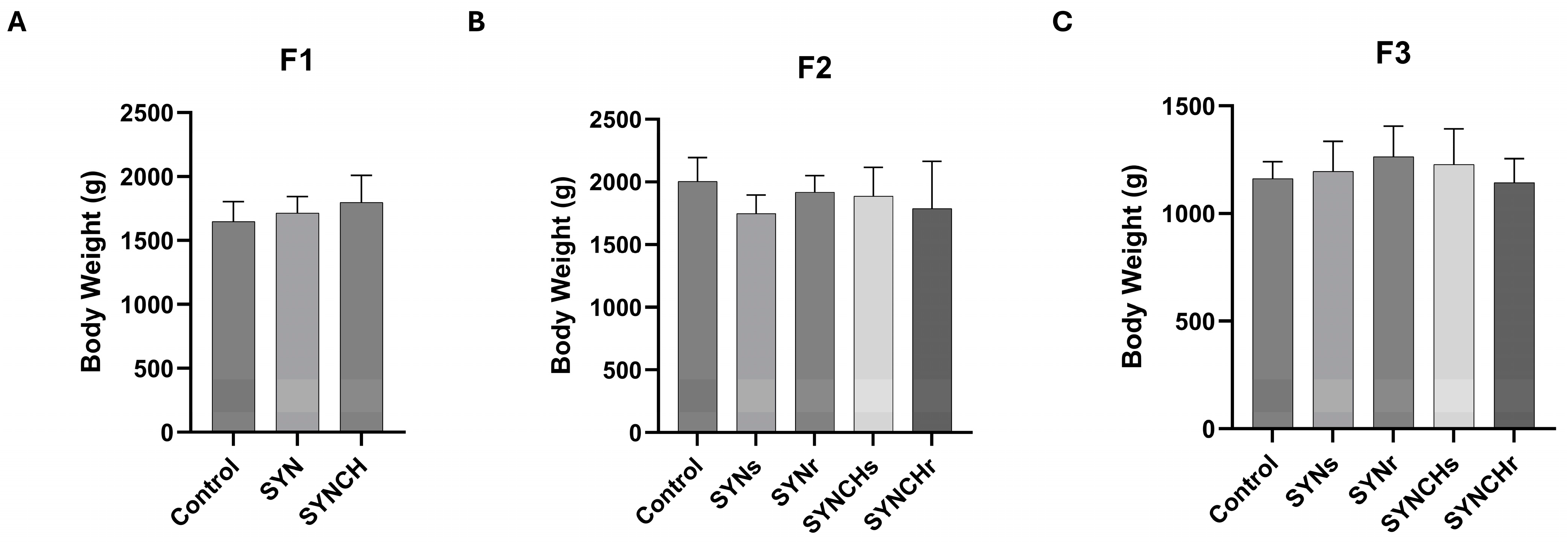

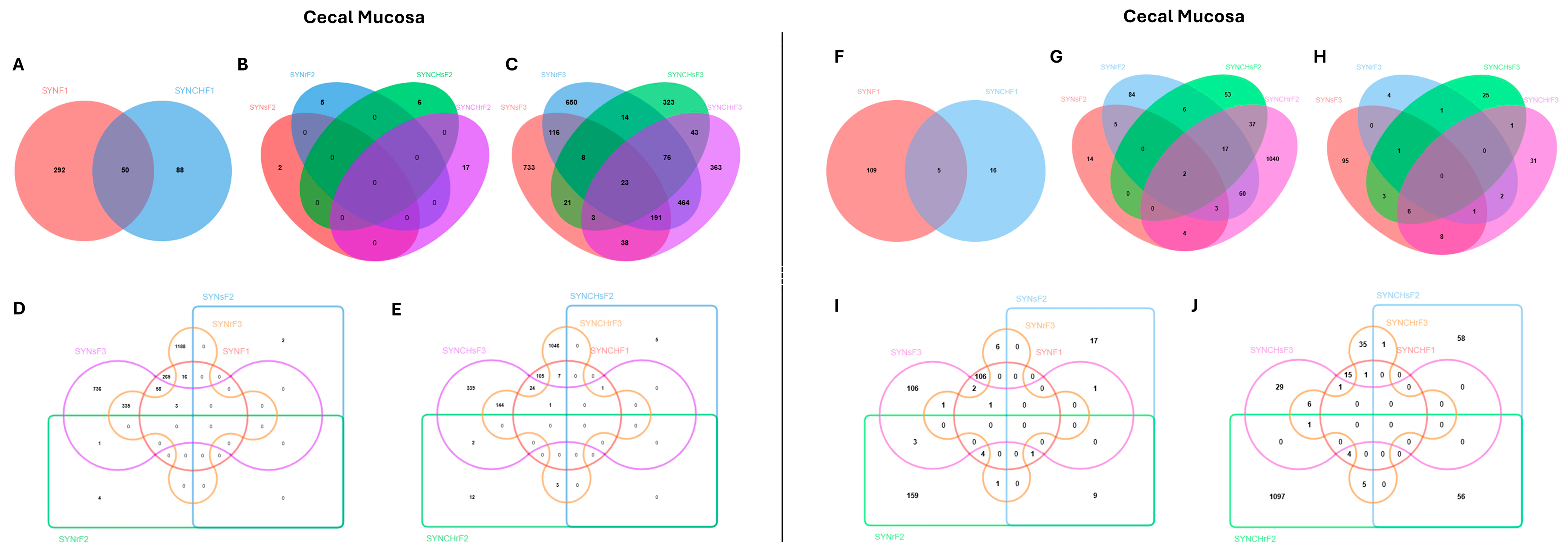
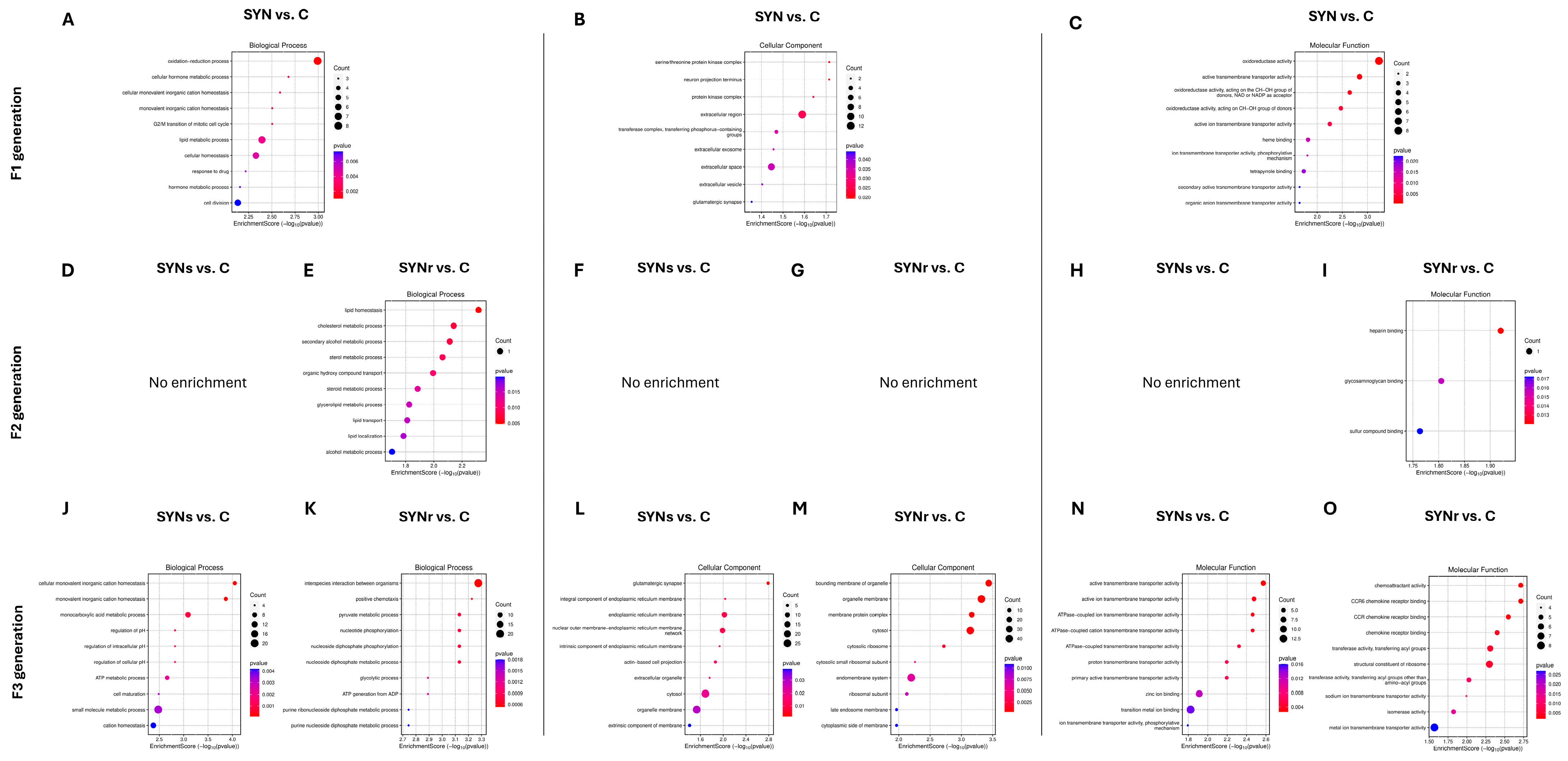

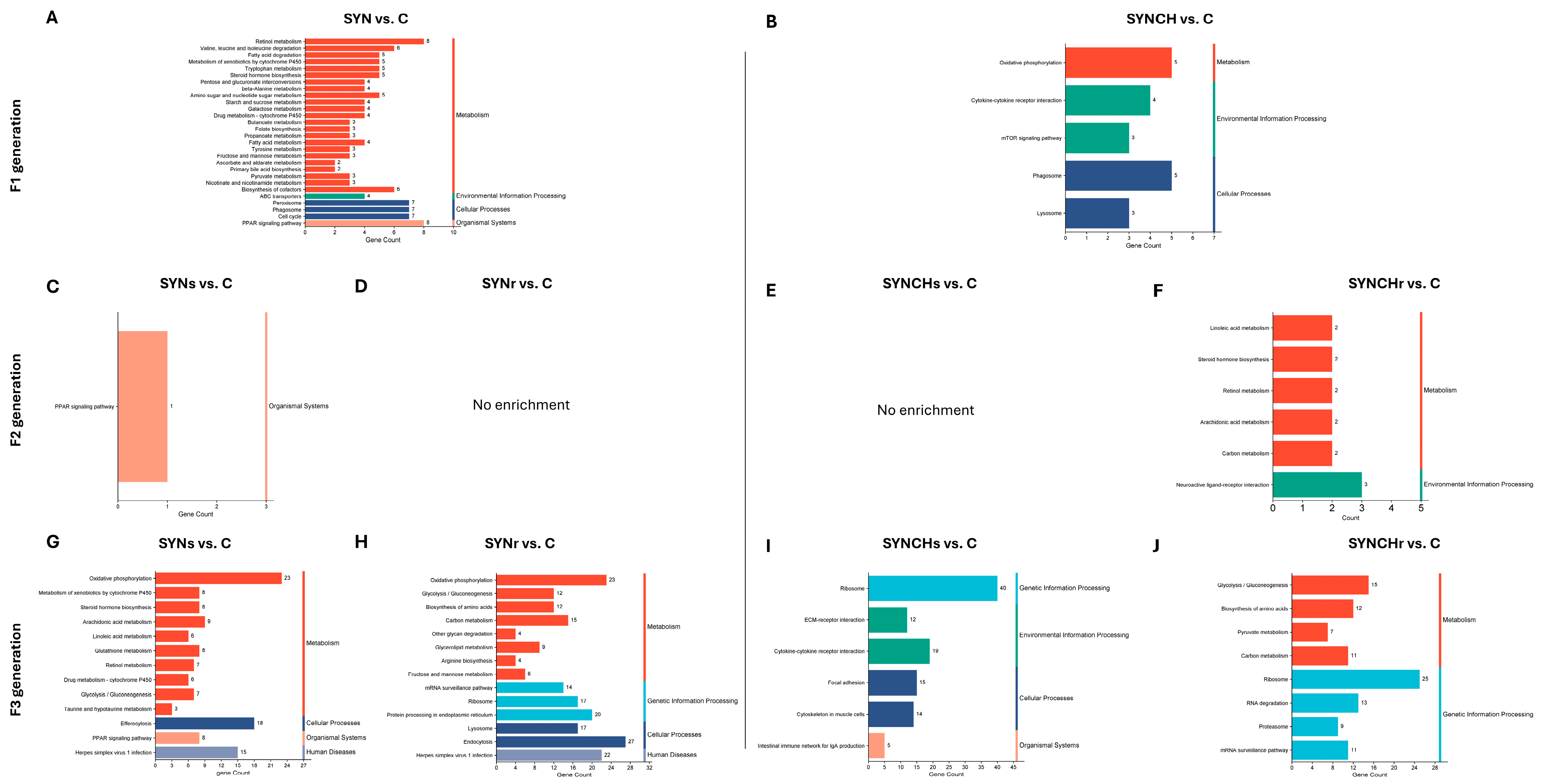
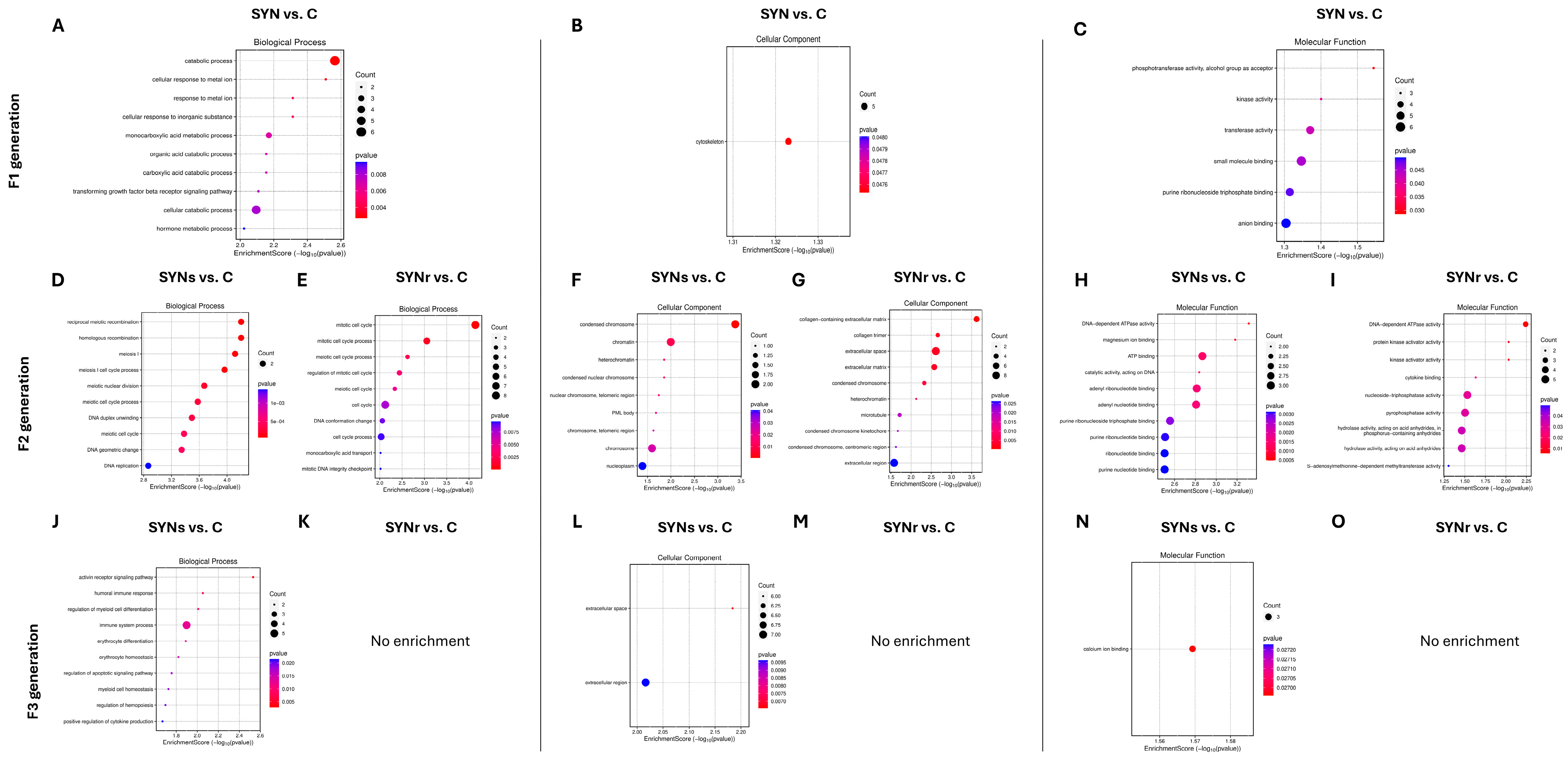
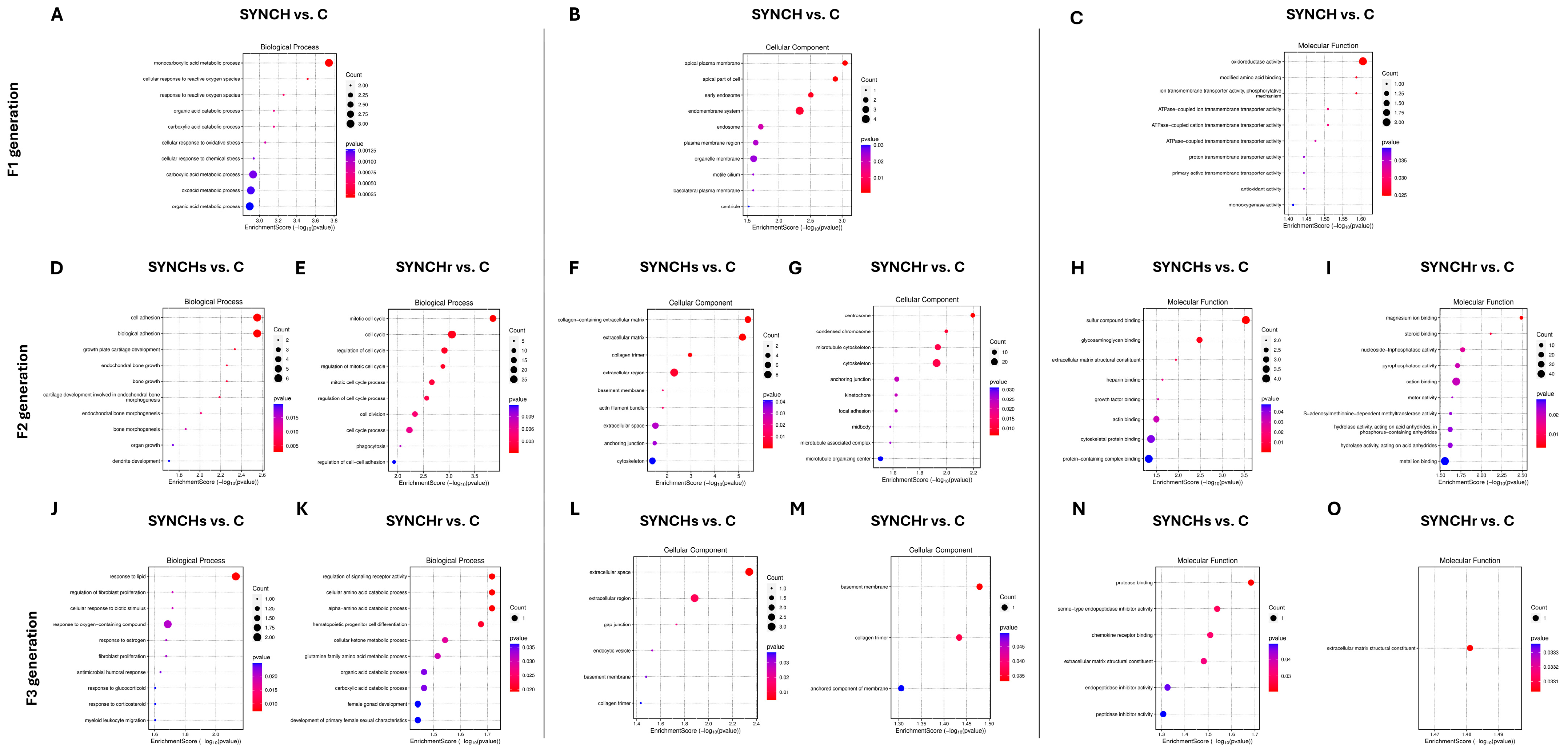
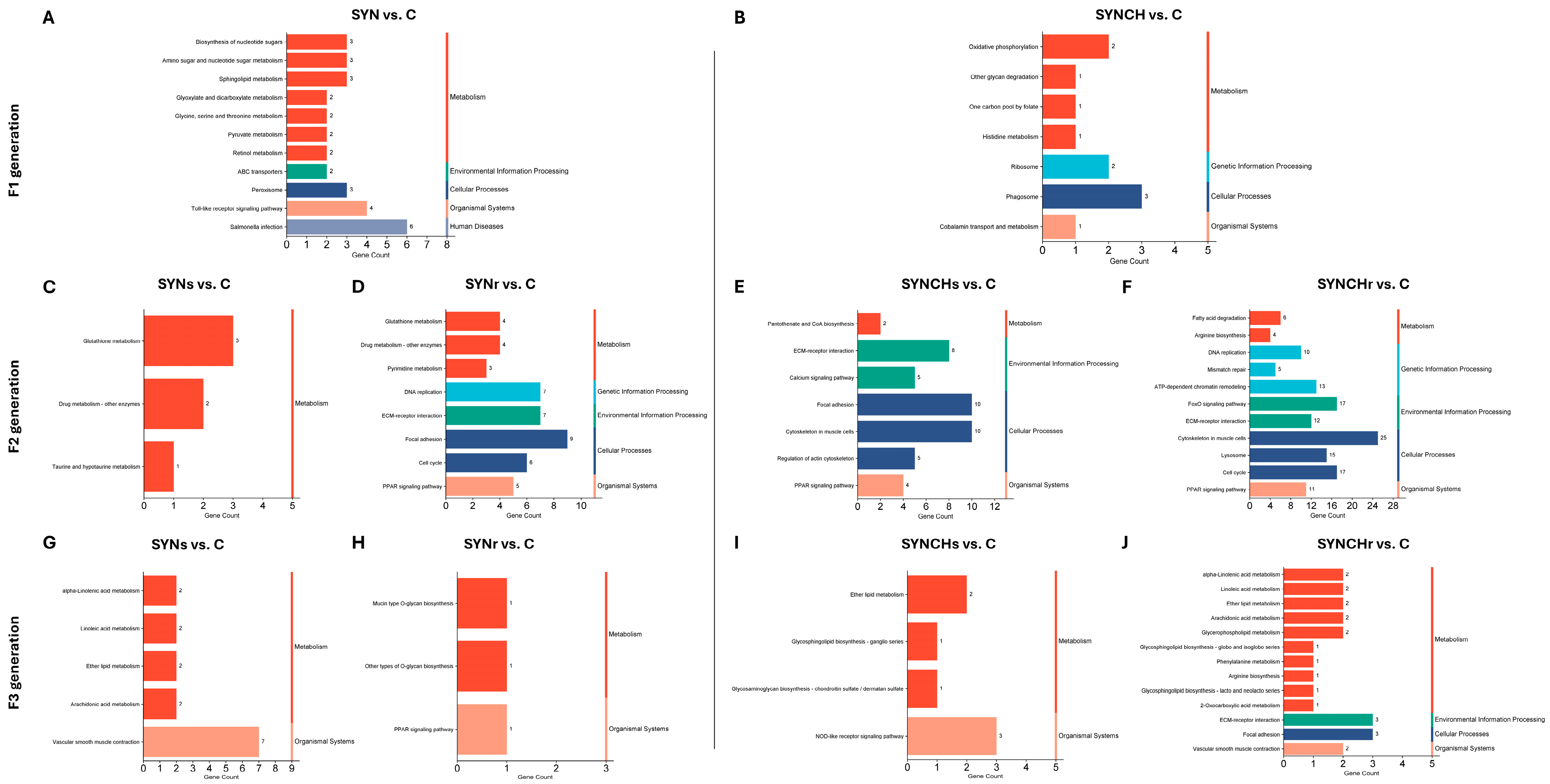
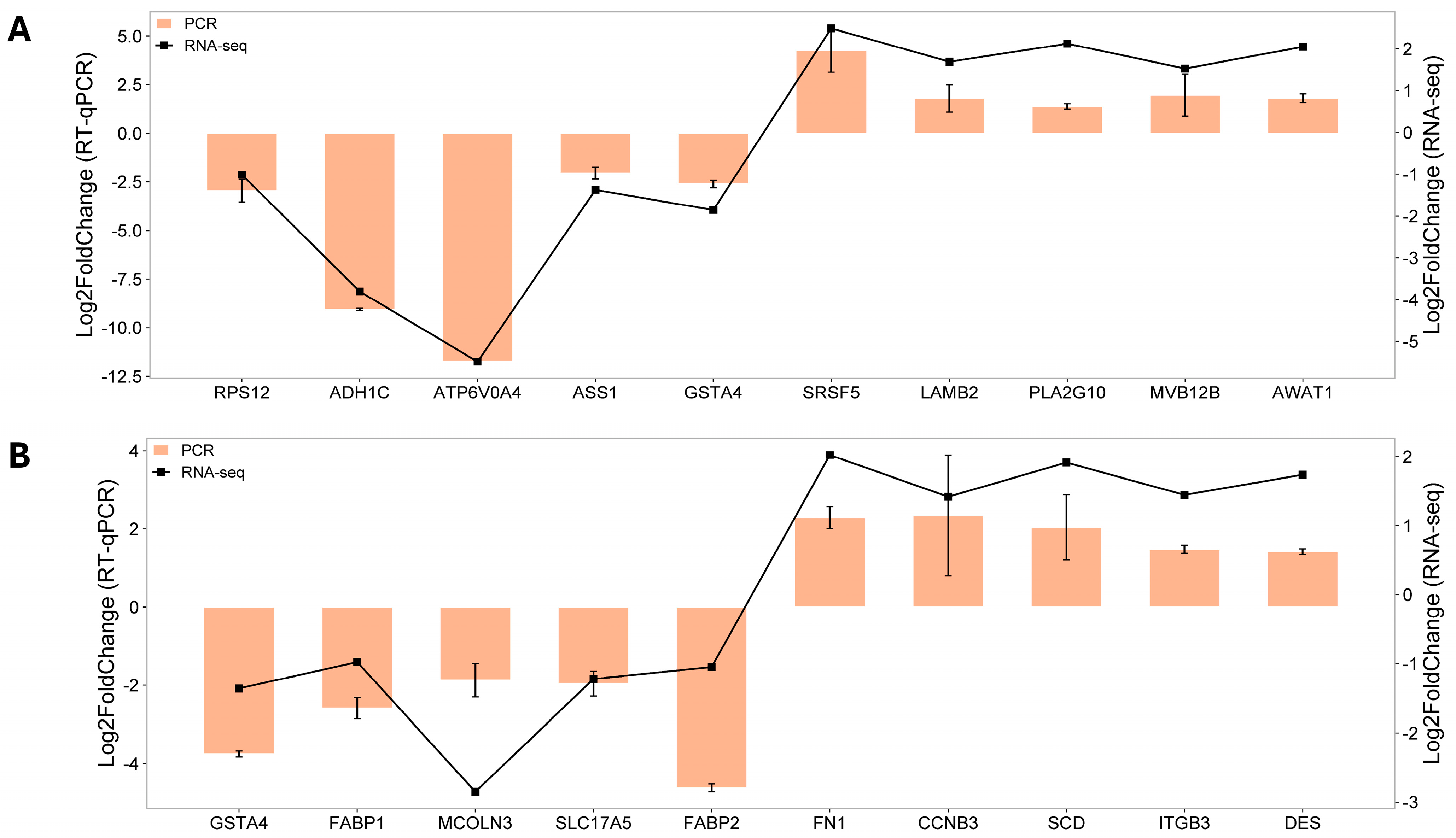
Disclaimer/Publisher’s Note: The statements, opinions and data contained in all publications are solely those of the individual author(s) and contributor(s) and not of MDPI and/or the editor(s). MDPI and/or the editor(s) disclaim responsibility for any injury to people or property resulting from any ideas, methods, instructions or products referred to in the content. |
© 2025 by the authors. Licensee MDPI, Basel, Switzerland. This article is an open access article distributed under the terms and conditions of the Creative Commons Attribution (CC BY) license (https://creativecommons.org/licenses/by/4.0/).
Share and Cite
Ibrahim, M.; Bednarczyk, M.; Stadnicka, K.; Grochowska, E. Inter- and Transgenerational Effects of In Ovo Stimulation with Bioactive Compounds on Cecal Tonsils and Cecal Mucosa Transcriptomes in a Chicken Model. Int. J. Mol. Sci. 2025, 26, 1174. https://doi.org/10.3390/ijms26031174
Ibrahim M, Bednarczyk M, Stadnicka K, Grochowska E. Inter- and Transgenerational Effects of In Ovo Stimulation with Bioactive Compounds on Cecal Tonsils and Cecal Mucosa Transcriptomes in a Chicken Model. International Journal of Molecular Sciences. 2025; 26(3):1174. https://doi.org/10.3390/ijms26031174
Chicago/Turabian StyleIbrahim, Mariam, Marek Bednarczyk, Katarzyna Stadnicka, and Ewa Grochowska. 2025. "Inter- and Transgenerational Effects of In Ovo Stimulation with Bioactive Compounds on Cecal Tonsils and Cecal Mucosa Transcriptomes in a Chicken Model" International Journal of Molecular Sciences 26, no. 3: 1174. https://doi.org/10.3390/ijms26031174
APA StyleIbrahim, M., Bednarczyk, M., Stadnicka, K., & Grochowska, E. (2025). Inter- and Transgenerational Effects of In Ovo Stimulation with Bioactive Compounds on Cecal Tonsils and Cecal Mucosa Transcriptomes in a Chicken Model. International Journal of Molecular Sciences, 26(3), 1174. https://doi.org/10.3390/ijms26031174





